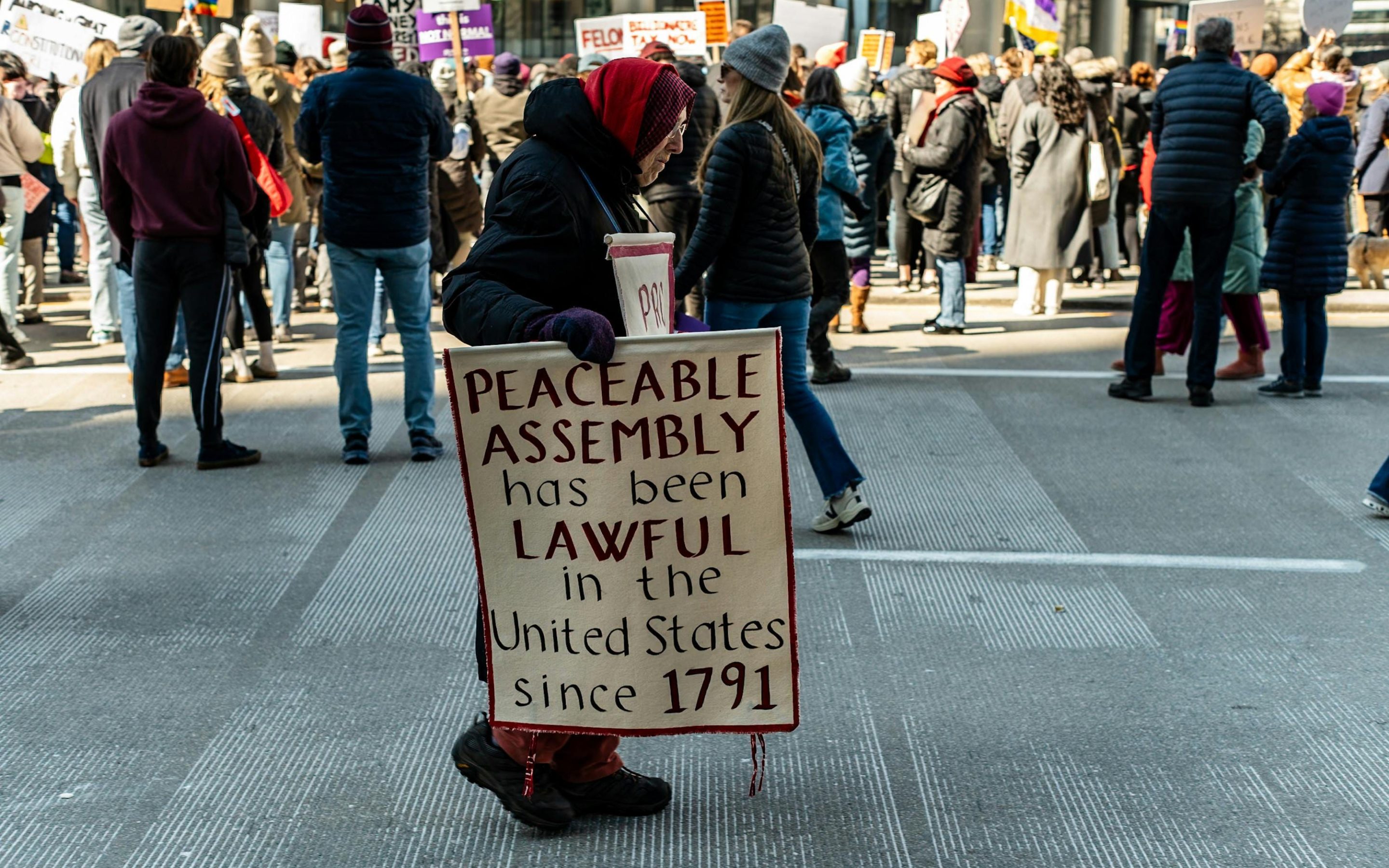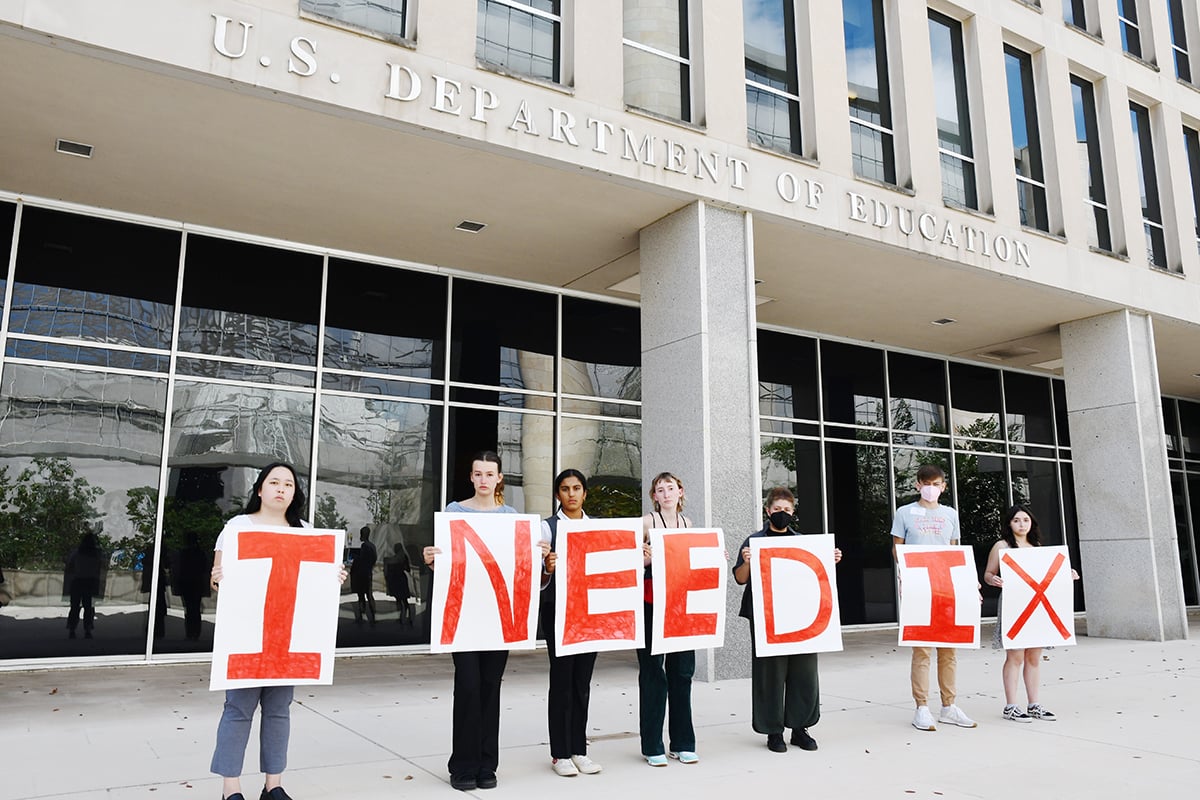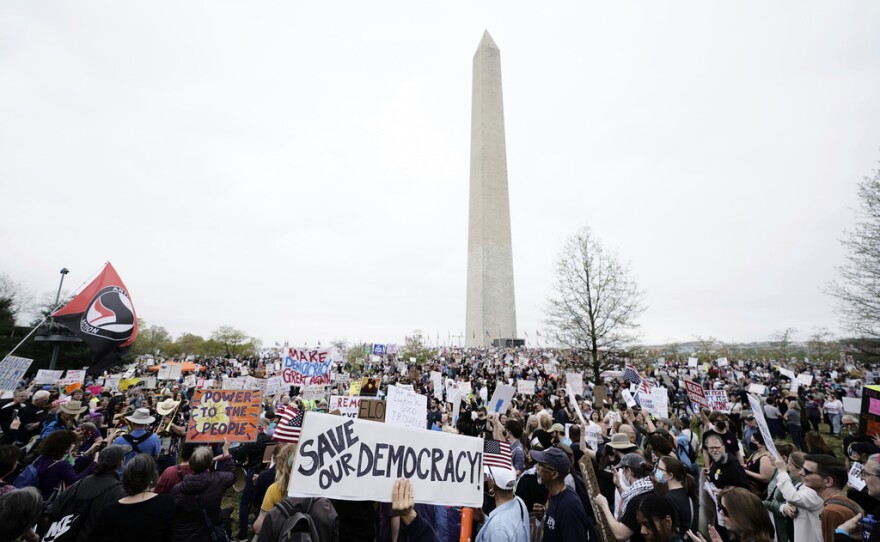
JOBS POLICIES, ANALYSIS, AND RESOURCES
Latest Jobs Posts
Trump’s Staff Reductions Leave FEMA Less Prepared: When the Helpers Don’t Show Up (Social Justice Policy Brief #180)
We’ve all seen the images on our screens — homes splintered, power gone, dazed residents wandering through shattered neighborhoods. They’re desperate for water, cell service, and food. Some are still searching for missing loved ones.
Europeans no longer feel safe because of Russia; A First Person Account (Foreign Policy Brief #218)
During my trip across Europe a week ago, I spoke with people from different countries — ordinary men and women I met along the way. I asked each of them whether they feel safe in their country today and whether they expect a war.
How the Trump Administration Shook Up Education — and What It Means for Students with Disabilities (Education Policy Brief #211)
While most of the major media headlines about the Trump Administration’s education policies have focused on ideological battles with the nation’s premier universities, a quieter but more radical reshaping is taking place at the heart of the American education system itself.
Saudi Arabia Enters the Video Game Industry (Foreign Policy Brief #219)
Saudi’s investments in sports, in particular, has been labeled “sportswashing” and a way for the Saudi Arabian government to increase its publicity and popularity in the world while also maintaining a regime that violates human rights. Their move into new sectors and industries has also been a part of their Saudi Vision 2030 program which aims to diversify their entire economy away from traditional fossil fuels (which has propped their economies for decades) and transition into a post-oil world. Is the move to purchase EA a new moment of economic diversification, or is it more in the way of “sportswashing”? The answer isn’t totally clear.
Trump’s Termination of U.S. Exchange Programs Weakens America at Home and Abroad
Diplomatic “soft power” is related to a country’s ability to influence other nations through its core values and culture. American democratic values including a free press, the legal justice system, and foreign engagement programs are potent sources of American soft power. When public trust in these American democratic norms and institutions wanes, America stands to lose its invaluable soft power. Among President Trump’s many actions that diminish U.S. soft power—from his persistent, pernicious attacks on the American media, legal system, electoral process, universities, and allies, to his constant maligning of past U.S. presidents and his racist mocking of current U.S. politicians—it’s Trump’s attempt to terminate the nation’s long-running international exchange and aid programs that could have the most deleterious effects, making America weaker at home and abroad.
The House Is on Fire: White America’s Own Civil War
For decades, America pretended its Civil War was over. It wasn’t. The battlefield just moved—from fields to feeds, from muskets to microphones, from soldiers to citizens.
Fortress Borders: the Rise of Anti-Immigrant Nationalism (Immigration Policy Brief #192)
International migration continues to grow, with the UN’s International Organization for Migration (IOM) estimating there were 281 million international migrants globally in 2020. While much migration is South-South (between developing nations), displacement from conflict, climate change, and economic instability drives significant South-North movement. This visible migration has become a foundational issue for populist movements, particularly in Europe and North America, which frame migrants as a threat to cultural identity and national security. In response, governments are increasingly adopting deterrence-focused policies, raising significant human rights concerns.
Coal Revival in the Age of Climate Emergency: Inside Trump’s New Energy Gamble (Environmental Policy Brief #183)
In a move that has startled climate scientists and energy economists alike, the Trump administration recently unveiled a sweeping new initiative aimed at reviving America’s coalindustry—a sector long regarded as both an economic relic and a climate catastrophe. The plan, a mix of subsidies, deregulation, and export promotion, represents a dramatic reversal of the Biden-era shift toward renewable energy and the most significant policy intervention in favor of coal since the early 2000s.
The Impact of New Energy Policy on the Coal Industry (Environmental Policy Brief #182)
Most economic and energy analysts define coal as having an impending obsolescence, regardless of government intervention. Forcing more years out of coal plants that are aging past their end of life will end up passing unnecessary costs onto consumers. A study by independent consulting firm Grid Strategies has found that the real cost of mining defunct coal facilities will end up costing end consumers up to $6 billion a year USD.


How the Trump Administration Shook Up Education — and What It Means for Students with Disabilities (Education Policy Brief #211)
Education Policy Brief #211 | Charlie Sweeney | October 23, 2025
While most of the major media headlines about the Trump Administration’s education policies have focused on ideological battles with the nation’s premier universities, a quieter but more radical reshaping is taking place at the heart of the American education system itself.
When the Trump administration took office on January 20, 2025, its first moves sent shockwaves through classrooms across the country — especially for students with disabilities. For decades, federal laws like the Rehabilitation Act of 1973 and the Individuals with Disabilities Education Act (IDEA) have guaranteed every child a free and appropriate education. But as the new administration began reorganizing the Department of Education, many families started to wonder whether those rights would still hold the same meaning.
Within weeks, the Department of Education announced major staff cuts and rolled back key guidance documents. Hundreds of employees who monitored compliance with IDEA were dismissed or reassigned. Offices that once advised schools on federal special-education requirements fell silent. The message was clear: less federal oversight, more “local control.” For families of children with disabilities, that meant confusion and uncertainty. Districts didn’t know which rules still applied or who to call for help. Reporting by Education Week and The Hechinger Report detailed how these cuts disrupted special-education oversight and left parents facing long delays in getting help for their children.
By mid-2025, the administration began exploring an even larger structural shift — moving special-education programs, including IDEA, out of the Education Department and into the Department of Health and Human Services. The stated goal was efficiency and flexibility for states. But critics saw danger ahead. Moving oversight away from career education specialists, they warned, could weaken the federal protections that millions of students depend on. Analysis from the Brookings Institution described this as one of the most sweeping bureaucratic reorganizations of special-education governance in half a century.
The legal rights of students with disabilities technically remain intact. But with fewer federal staff, slower investigations, and shifting rules for grant distribution, those rights are harder to enforce. Schools may delay evaluations or reduce therapy and support services. In under-resourced districts, families could lose access to the very protections the 1970s laws were meant to guarantee. A review by the Center on Budget and Policy Priorities warned that these moves risk deepening inequities, leaving enforcement up to the uneven capacities of individual states.
Conclusion
The 2025 Trump administration’s changes didn’t repeal the landmark laws protecting students with disabilities — but they weakened the system that upholds them. Parents, advocates, and educators now face a tougher fight to ensure that every child, regardless of ability, continues to receive the education they are promised under federal law.
Sources
- Center on Budget and Policy Priorities — “Trump Administration Threatens Support for Children with Disabilities.”
- Education Week — “How Trump’s Layoffs Threaten Students with Disabilities.”
- Brookings Institution — “Trump Administration Weighs Future of Special Education Oversight and Funding.”
- Hechinger Report — “Parents, Advocates Alarmed as Trump Leverages Shutdown to Gut Special Education Department.”

Saudi Arabia Enters the Video Game Industry (Foreign Policy Brief #219)
Foreign Policy Brief #219 | Reilly Fitzgerald | 10/9/2025
Policy Summary
The Saudi Arabian Public Investment Fund (PIF) purchase of the video gaming company- Electronic Arts (EA)- comes with a $55 billion price tag. It is a joint-venture between the PIF and the private equity firm Silver Lake , and Jared Kushner’s Affinity Partners (another private equity firm). The purchase will take EA from a public company to a privately-owned company, which means that all of the stock in the company will be entirely owned by the PIF and Silver Lake, and cannot be purchased.
According to the BBC, $36 billion of the deal will be paid directly by the PIF and Silver Lake, and the remainder will be purchased with loans. The move is interesting on many levels, according to Axios, Saudi Arabia already had a 9.9% stake in EA prior to the purchase. Also, Jared Kushner is directly involved in the purchase involving Saudi Arabia at a time when he is in the Middle East (for the Gaza peace deal) as senior advisor to the President of the United States, his father-in-law, is quite intriguing if not worrying.
Analysis
Electronic Arts, known as EA, is one of the world’s most popular and prolific video gaming companies. Their games include EA FC (formerly known as the FIFA franchise of games), the Madden franchise, Battlefield, NBA, NHL, and many other wildly popular games! Video games is an industry with tremendous reach globally. Since 1993, 325 million copies have been sold around the world of EA FC, and FIFA as it was formerly known ; making it one of the most popular game series ever. In the United States, Madden is the most popular sports game which gets its name from NFL legend John Madden.
Saudi Arabia’s Public Investment Fund, or PIF, has been a soft power tool of the Saudi government. The PIF Fund has helped increase Saudi investment in various sectors and strengthen Saudi relationships with countries. PIF is a major owner and investor in football (or soccer) clubs around the world with the likes of Newcastle United in the UK.
Saudi’s investments in sports, in particular, has been labeled “sportswashing,” i.e. it has been a way for the Saudi Arabian government to increase its publicity and popularity while also maintaining a regime that violates human rights. Their move into new sectors and industries has also been a part of their Saudi Vision 2030 program which aims to diversify their entire economy away from traditional fossil fuels (which has propped their economies for decades) and transition into a post-oil world. Is the move to purchase EA a new moment of economic diversification, or is it more in the way of “sportswashing”? The answer isn’t totally clear.
Saudi Arabia has invested heavily in the video game industry for years. The Saudi PIF owns the Savvy Games Group, which in 2023 bought Scopely, a video game company that owns products like (the very popular) PokémonGO, MonopolyGO, and ScrabbleGO, among many other games. Scopely was bought by Savvy Games Group for $4.9 billion.
Saudi Arabia is also hosting the eSports World Cup, and the Olympic eSports Games in 2027 (an International Olympic Committee [IOC] event). The government is already involved with Nintendo and TakeTwo Interactive, which are both video game companies.
The Saudi Arabian PIF’s purchase of Electronic Arts (EA) comes with a $55 billion price tag, and is a joint-venture between the PIF and Silver Lake, which has direct ties to Jared Kushner’s Affinity Partners. The purchase will take EA from a public to a privately-owned company, which means that all of the stock in the company will be entirely owned by the PIF and Silver Lake, and cannot be purchased. According to the BBC, $36 billion of the deal will be paid directly by the PIF and Silver Lake, and the remainder will be purchased with loans.
The move is interesting on many levels, according to Axios, Saudi Arabia already had a 9.9% stake in EA prior to the purchase. Also, Jared Kushner being directly involved in the purchase involving Saudi Arabia at a time when he is in the Middle East (for the Gaza peace deal) as senior advisor to the President of the United States, his father-in-law, is quite intriguing if not worrying.
So, is it “sportswashing”, or “gamewashing”? It remains yet to be seen. However, it is clear that Saudi Arabia is interested in investing and purchasing brands around the world in various industries to increase their relations with foreign governments. It remains to be seen if this is a soft power tool, just a means to diversify their oil dependent economy into burgeoning industries.
Engagement Resources
- Saudi Vision 2030 – https://www.vision2030.gov.sa/en
- Savvy Games Group (PIF) – https://www.pif.gov.sa/en/our-investments/our-portfolio/savvy-games-group/
- Olympic eSports Games (IOC) – https://www.olympics.com/ioc/olympic-esports-games

Trump’s Termination of U.S. Exchange Programs Weakens America at Home and Abroad
Education Policy Brief #210 | Nicholas Gordon | October 23, 2025
Summary
Diplomatic “soft power” is related to a country’s ability to influence other nations through its core values and culture. American democratic values including a free press, the legal justice system, and foreign engagement programs are potent sources of American soft power. When public trust in these American democratic norms and institutions wanes, America stands to lose its invaluable soft power. Among President Trump’s many actions that diminish U.S. soft power—from his persistent, pernicious attacks on the American media, legal system, electoral process, universities, and allies, to his constant maligning of past U.S. presidents and his racist mocking of current U.S. politicians—it’s Trump’s attempt to terminate the nation’s long-running international exchange and aid programs that could have the most deleterious effects, making America weaker at home and abroad.
Analysis
In August, The Office of Management and Budget (OMB) announced plans to cut funding for at least 22 Bureau of Educational and Cultural Affairs (ECA) programs, deeming them “lower funding priorities.” No matter that congressionally approved funding for these programs was already established for fiscal year 2025 (FY25). While the executive branch is responsible for protecting and executing the constitutional laws and ensuring funds are properly appropriated, the Trump administration instead shows brazen disregard for congress’s ‘power of the purse,’ that is, its constitutional authority to designate funding for these federal programs.
The American Economy Will Suffer
Venerable U.S. exchange programs bolster America’s economy and security, help develop crucial networks and partnerships, and create leaders and change-makers. The nonprofit advocacy group the Alliance for International Exchange estimates that more than 8,000 Americans stand to lose their jobs with the OMB funding cuts to U.S.-based ECA-partner organizations, while the American economy will squander billions of dollars. Representatives from both parties recognize the crucial role exchange programs play not just in the American economy but also in driving American influence and contributing to U.S. foreign policy objectives. Senators Cory Booker and Susan Collins, among others, have urged the administration to respect Congress’s approved funding. The leaders emphasize that exchange programs are one of the best returns on investment in federal funding, with 90% of exchange funding spent on American educators, institutions, and communities.
Damaging Global Partnerships
The robust bipartisan support for U.S exchange programs that has existed for decades has enabled crucial global partnerships to develop. OMB’s funding cuts on exchange programs will undermine years of U.S. diplomatic efforts. Just as Trump’s dismantling of the 64-year-old U.S. Agency for International Development (USAID) was criticized by geopolitical analysts as a reckless abandonment of international relationships and support networks that took decades to build, the termination of exchange programs will further damage America’s credibility with global partners. Trashing the trust earned with allies is a blunder more costly than cutting foreign aid. Meanwhile, rivals like China and Russia could gain a competitive advantage by filling the void left by Washington’s retreat from partnerships with developing nations.
The Human Factor
U.S. Exchange programs provide a wealth of opportunities for education, relationship-building, and personal and professional growth. English Language Programs, for example, sends U.S. educators abroad to help build English language teaching capacity and foster cross-cultural understanding, which galvanizes the participants’ careers as they return home with expanded skill sets and enriched perspectives. The Community Engagement Exchange develops emerging civil society leaders with skills, resources, and networks to implement projects on civics, peacebuilding, and sustainability. The Community College Administrator Program trains international education leaders in postsecondary school administration, workforce development, and private sector partnerships.
American citizens participating in exchange programs embody American values of hard work, leadership, support, innovation, and collaboration. Participants have a chance to share their diverse perspectives and experiences, while learning about those of people from other countries, too. Friendships are forged; professional relationships are established. Building these cultural bridges leads to new projects that improve people’s lives and strengthen communities. In other words, there’s more than just money at stake here, which is something that a corrupt deal-maker might never understand: Trump is shattering the livelihoods and callings of hardworking Americans dedicated to bettering the country and the world through exchange programs.
No Going Back
While some of America’s partners might view Trump as an ugly aberration of America’s democratic leadership and await the return of a more diplomatically astute presence in the White House, many others will not. They will recognize that the America they trusted and shared values with does not exist anymore, and they will move on. American soft power will flounder in their wake. The rebuilding of these substantive U.S. global partnerships and the restoring of U.S credibility will not come easy, if it comes at all.
Engagement Resources:
- The Center for American Progress
- An independent, nonpartisan policy institute “dedicated to improving the lives of Americans through bold, progressive ideas, strong leadership and concerted action”
- Alliance for International Exchange
- “Promotes the growth and impact of U.S. international exchange programs and the effectiveness of its members, organizations, and companies”
- American Civil Liberties Union
- Non-profit organization that defends individual rights and liberties guaranteed by the U.S. Constitution and laws

The House Is on Fire: White America’s Own Civil War

Fortress Borders: the Rise of Anti-Immigrant Nationalism (Immigration Policy Brief #192)
Immigration Policy Brief #192 | Inijah Quadri | October 16, 2025
Policy Issue Summary
International migration continues to grow, with the UN’s International Organization for Migration (IOM) estimating there were 281 million international migrants globally in 2020. While much migration is South-South (between developing nations), displacement from conflict, climate change, and economic instability drives significant South-North movement. This visible migration has become a foundational issue for populist movements, particularly in Europe and North America, which frame migrants as a threat to cultural identity and national security. In response, governments are increasingly adopting deterrence-focused policies, raising significant human rights concerns.
In Europe, the EU’s Pact on Migration and Asylum entered into force on June 11, 2024, and will be applied after a two-year transition. It promises “strong and secure external borders” alongside common screening and fast-track procedures that make detention and returns easier. Core parts of the Pact include: (1) mandatory pre-entry screening (identity, health, security) typically within 7 days; (2) new fast-track “border procedures” to decide some asylum claims or refusals in up to 12 weeks (extendable), with more possibilities for detention; (3) expanded Eurodac fingerprint/biometrics (including for children) to track entries; and (4) a “solidarity” system where states can relocate people or pay financial contributions instead of relocating. Full application is expected from mid-2026 after the transition period.
At the national level, member states are also tightening controls. In Germany, a “Repatriation Improvement Act” took effect in Feb 2024 to speed deportations and expand detention/search powers. Germany and several neighbors also extended internal Schengen border checks (temporary controls reimposed at the borders between countries within Europe’s passport-free travel zone) into 2025 to curb irregular entries.
Europe is also aggressively outsourcing migration control. The EU’s migration deal with Tunisia (Memorandum of Understanding, July 16, 2023) tied over €1 billion in support to cooperation against irregular migration, including €105 million for border management. However, investigations in 2024–2025 documented widespread abuses by EU-funded Tunisian units, including beatings and the dumping of Black migrants in the desert, prompting renewed criticism. Simultaneously, Italy’s plan to process asylum seekers in Albania has been hit by a series of legal blows in 2025. While Italy signed a deal to transfer people intercepted at sea to Albanian centers for processing, courts have pushed back. In October 2024, the Court of Rome ordered 12 people returned from Albania to Italy, and in August 2025, the EU Court of Justice narrowed how “safe country” shortcuts can be used, delaying the scheme’s implementation.
In the United States, deterrence has shifted into overdrive. Refugee admissions have been frozen pending a new cap reportedly as low as 7,500 for FY2026. Authorities have redirected spy-satellite surveillance to the border and dismantled the CBP One app’s asylum scheduling function. CBP One was a mobile application that once scheduled asylum appointments at ports of entry. The app has been rebranded “CBP Home,” now tied to “self-deportation” and mass parole revocations.
Reports indicate the administration is preparing this record-low refugee cap for FY2026, with most reports suggesting priority will be given to white South African (Afrikaner) refugees. This selective pathway can be framed as prioritizing a nationality/minority group rather than setting an explicit racial quota, though rights groups criticize it as discriminatory. Even more, South Africa disputes that these white Afrikaners face persecution.
This trend is not limited to the Global North. In the Asia-Pacific region, restrictive policies are also gaining ground. Pakistan has resumed large-scale expulsions of Afghans, including people awaiting resettlement to the U.S., despite warnings from UN experts and humanitarian groups. In July–August 2025, after Proof-of-Registration cards expired, Pakistan restarted mass deportations/forced returns of Afghans, drawing formal warnings from UN human-rights experts. Meanwhile, in June 2023, Japan amended its Immigration Control and Refugee Recognition Act to allow deportation of people who apply for refugee status more than twice and to expand detention powers. Rights groups say this increases refoulement (the forced return of refugees or asylum seekers to a country where they are liable to be subjected to persecution) risks and Japan continues to recognize very few refugees each year.
The International Organization for Migration reports 2024 as the deadliest year on record for migrants worldwide, with the Mediterranean again among the most lethal routes. IOM recorded at least 8,938 deaths on migration routes in 2024 — the highest on record. Most deaths are from drowning (about 60% worldwide), followed by vehicle crashes, exposure/dehydration, and violence; the Mediterranean remained one of the deadliest corridors.
Analysis
The prevailing anti-immigrant nationalism promotes a simple, fear-driven narrative: borders are under siege, and only increasingly harsher government crackdown tactics can restore order. The EU Migration and Asylum Pact translates this narrative into law, institutionalizing swift border screenings, broadened detention, and a “return-first” mindset. Although the Pact contains formal rights language, its core design fundamentally shifts power toward containment and away from protection. Notably, the Pact formalizes expanded “border procedures” with curtailed in-country movement during processing and toughens data-collection rules in Eurodac.
This model’s inherent fault lines are starkly exposed through the externalization of border control. For example, Italy’s controversial Albania scheme attempts to move responsibility offshore, yet European courts have pushed back, challenging the idea that people can be expelled from the EU’s legal safeguards. Similarly, deals with nations like Tunisia involve exchanging funds for interdiction despite documented human rights abuses. This constitutes migration control by proxy, a system operating with less transparency and creating far greater risks for people on the move. Recent court and watchdog findings underline those risks: rulings in Rome and at the EU level have constrained “safe country” shortcuts, while reporting in 2024–2025 documented EU-funded Tunisian units committing abuses against Black migrants.
Pushbacks—summary expulsions without a genuine opportunity to seek asylum—have transitioned from isolated scandal to entrenched practice. In January 2025, the European Court of Human Rights (ECHR) affirmed these violations by ruling against Greece in several key cases. On 7 January 2025, the ECHR decided A.R.E. v. Greece and G.R.J. v. Greece, finding strong indications of systematic pushbacks to Türkiye and violations of Articles 3 and 13 (ill-treatment and lack of effective remedy). While such legal rulings are vital, they remain insufficient to end collective punishment at Europe’s edges unless paired with robust political will.
The tragic reality of sea rescues illustrates how specific policy choices cost lives. Humanitarian organizations, such as Médecins Sans Frontières (MSF), have extensively documented state obstruction, including detaining NGO ships, assigning intentionally distant ports, and creating hostile conditions that undermine lifesaving missions. When rescue is treated as a liability rather than a necessity, more people inevitably disappear at sea. Central Mediterranean departures typically involve overcrowded rubber dinghies or unseaworthy wooden boats leaving Libya or Tunisia. Under international maritime law (SOLAS and the SAR Convention), all vessels and states must rescue people in distress and disembark them in a “place of safety.” Rules that make NGO rescue ships travel to distant ports (like those in northern Italy) after each rescue add extra days at sea and keep them away from the search area. Italy has also repeatedly detained NGO vessels.
In the United States, physical deterrence is increasingly paired with digital controls. Authorities have curtailed port-of-entry asylum access, revoked the parole status of hundreds of thousands who entered via the CBP One app, and rebranded the app to push people toward “voluntary” departure. Simultaneously, the Department of Homeland Security (DHS) champions AI-driven surveillance, biometrics, and a “smart wall” as force multipliers. This technology, however, does not neutralize the underlying punitive politics; it merely automates them.
Legal and electoral challenges offer crucial avenues to slow the crackdown. In the U.S., Texas’s SB 4—which sought to allow state arrests of suspected undocumented migrants—was ultimately ruled unconstitutional by the Fifth Circuit in July 2025 and remains blocked. This means Texas still cannot enforce the law while the case continues. Across the Atlantic, the UK’s Supreme Court ruling in 2023, coupled with a change in government, effectively ended the controversial Rwanda offshoring plan, leading to thousands of asylum claims from people previously targeted for removal to Rwanda. These outcomes prove that these punitive policies can fail on the grounds of legality, cost, and basic efficacy.
A fundamentally different approach is possible. This involves expanding regular, safe migration pathways and establishing fair asylum processing. It means funding robust reception and integration services instead of relying on detention and outsourcing. Furthermore, it demands that rescue at sea be protected and enabled, and that surveillance be strictly limited to what is both necessary and rights-compliant. None of this is utopian; it builds on legal precedent, extensive watchdog reporting, and community resistance that have already forced course corrections. The essential choice is between systems that view and treat people as threats and systems that honor and treat people as human.
At the UN level, two key compacts set the framework: the Global Compact for Safe, Orderly and Regular Migration (2018, a non-binding agreement outlining objectives for managing migration) and the Global Compact on Refugees (2018, a framework for more predictable and equitable responsibility-sharing). The 2023 Global Refugee Forum (a quadrennial event to track progress and announce new pledges) produced over 1,750 pledges, totaling about $2.2 billion. Progress on the migration compact is reviewed every four years at the International Migration Review Forum (IMRF), with the next session scheduled for 2026.
Engagement Resources
- Human Rights Watch (https://www.hrw.org/): Reporting and advocacy on migration, pushbacks, and border surveillance.
- Amnesty International (https://www.amnesty.org/): Legal analyses and urgent actions on detention, externalization, and asylum access.
- ACLU (https://www.aclu.org/): Litigation and monitoring on U.S. immigration enforcement and civil liberties.
- Border Violence Monitoring Network (https://www.borderviolence.eu/): Field documentation of pushbacks and violence along the Balkan and Greek routes.
- Statewatch (https://www.statewatch.org/): Investigations into European border policing, surveillance, and the criminalization of solidarity.
- Alarm Phone (https://alarmphone.org/): Civil hotline supporting people in distress at sea and documenting non-assistance.
- Refugees International (https://www.refugeesinternational.org/): Policy reporting on displacement drivers, resettlement, and humanitarian access.

Coal Revival in the Age of Climate Emergency: Inside Trump’s New Energy Gamble (Environmental Policy Brief #183)
Environmental Policy Brief #183 | Charles Sweeney | October 13, 2025
In a move that has startled climate scientists and energy economists alike, the Trump administration recently unveiled a sweeping new initiative aimed at reviving America’s coalindustry—a sector long regarded as both an economic relic and a climate catastrophe. The plan, a mix of subsidies, deregulation, and export promotion, represents a dramatic reversal of the Biden-era shift toward renewable energy and the most significant policy intervention in favor of coal since the early 2000s.
At its core, the initiative seeks to achieve three things: restore federal price subsidies for coal producers, delay the scheduled closure of aging coal plants, and provide federal support to expand coal exports to global markets. To its proponents, the plan is a bid to bring economic life back to struggling mining towns across Appalachia and the Midwest. To its critics, it’s a dangerous political maneuver that risks undoing decades of progress toward global climate goals.
The Return of the Dirtiest Fuel
Coal, long known as the dirtiest fossil fuel, holds a notorious place in the climate ledger. According to the Intergovernmental Panel on Climate Change (IPCC), coal alone has contributed nearly 1.62°F to 2.2°F rise in global average temperature since the Industrial Revolution began. Per unit of energy,coal releases more than twice as much carbon dioxide as natural gas, and its combustion produces additional pollutants—mercury, sulfur dioxide, and fine particulate matter—that directly harm human health.
Scientists warn that any resurgence in coal use will have far-reaching environmental consequences: deeper droughts, more intense hurricanes, and longer, deadlier heatwaves. The global climate system, already strained by accelerating emissions from transportation and agriculture, can ill afford a large-scale return to coal.
Climate and energy analysts describe the issue with fossil fuels, coal in particular, as “ a feedbackloop,” where the burning of more coal means more heat, which means higher energy demand forcooling, which then fuels the argument for more cheap power—often from coal again.
Deregulation by Design
The administration’s new coal plan leans heavily on deregulation. It repeals key parts of the Obama-era Clean Power Plan, replacing them with the more lenient Affordable Clean Energy (ACE) rule. The ACE rule reduces federal oversight over several toxic byproducts of coal burning, including coal ash disposal, mercury emissions, and methane leakage. These changes effectively weaken safeguardsdesigned to protect both the atmosphere and the water tables in coal-producing regions.
Environmental advocates warn that this rollback could result in elevated levels of mercury inwaterways and an increase in airborne particulates— both linked to respiratory illness and developmental issues in children.
Meanwhile, the new regulatory framework allows utilities to extend the lifespan of inefficient coalplants that were previously slated for retirement.
While deregulation may ease short-term costs for plant operators, experts note that it does little toaddress coal’s fundamental problem: it is no longer competitive. Even without strict regulations, renewable energy— particularly wind and solar—remains cheaper in most markets. The decision to double down on coal, then, appears driven less by economics and more by politics.
A Political Play with Global Stakes
Coal country remains a vital part of Trump’s political base. Once the backbone of American industrial might, many of these regions have suffered steep job losses and population decline asmines shuttered and automation reduced labor demand. By positioning himself as coal’s last champion, Trump is appealing to a demographic that feels left behind in the energy transition.
But global energy trends tell a different story. Despite rising demand for electricity—fueled by artificial intelligence, data centers, and electrification—most industrialized nations are investing in renewables and nuclear power rather than coal. China, the world’s largest coal consumer, hasindeed built new coal plants, but even there, the long-term trajectory points toward cleaner sources.
In the U.S., the connection between rising energy demand and new fossil fuel investment hasbecome especially visible through the lens of artificial intelligence. Mega-projects such as Project Stargate (a partnership between OpenAI, SoftBank, and Oracle), xAI’s Colossus in Tennessee, and Meta’s Hyperion in Louisiana have all required immense, reliable power sources. Yet even theseenergy-hungry facilities are turning to natural gas and nuclear power—sources that, while not carbon-free, are cleaner than coal.
An Uncertain Future for Energy Transition
The administration argues that coal could help stabilize electricity costs amid growing strain on thenational grid. But experts warn that subsidizing coal risks diverting billions from investments in renewable infrastructure and transmission lines that could deliver cheaper, cleaner energy in the long run.
A recent example underscores this concern: in July 2025, the Department of Energy canceled a $4.9 billion loan guarantee for the Grain Belt Express, an 800-mile transmission line designed to carry Kansas wind power to Illinois and Indiana. The project—shorter than similar ones already built in China—fell victim to political opposition from rural landowners and Republican lawmakers. For many climate advocates, the withdrawal signaled a broader retreat from renewable ambition.
The scientific verdict remains clear: a renewed embrace of coal will almost certainly slow, if not reverse, U.S. progress toward the emission-reduction targets established under the Paris Climate Accord. While the administration frames its coal initiative as an energy security measure, it may in fact deepen America’s dependence on outdated technologies—and lock in decades of additional carbon emissions.
In an age defined by climate volatility, Trump’s coal revival looks less like an energy policy and more like a bet against the planet’s future.

The Impact of New Energy Policy on the Coal Industry (Environmental Policy Brief #182)
Environmental Policy Brief #182 | William Campbell | October 2025
Most economic and energy analysts define coal as having an impending obsolescence, regardless of government intervention. Forcing more years out of coal plants that are aging past their end of life will end up passing unnecessary costs onto consumers. A study by independent consulting firm Grid Strategies has found that the real cost of mining defunct coal facilities will end up costing end consumers up to $6 billion a year USD.
Despite the administration’s efforts to revive the coal industry, economists project that consumer sensibilities will lead them to eventually start relying on more efficacious and financially solvent energy resources. As coal becomes precipitously less competitive, its market share will atrophy, even if funds are continuously pumped into it. In September of 2025, it was announced that $625 million would be apportioned for updating and retrofitting coal-producing facilities in the U.S.. However, it has generally been considered a fruitless endeavor, given that said sum won’t go far in modernizing decades-old plants.
Eliminating or relaxing restrictions on wastewater discharges from coal plants, as proposed by the Trump administration, would cause water treatment plants to operate at higher capacity and scrutiny. Assurances of air and water pollution control would disappear, increasing greenhouse gas emissions. The atmosphere would be filled with increased pollutants from heavy metals, mercury, soot, and sulfur dioxide, which are linked to chronic cardiovascular, neurological, and respiratory conditions, as well as cancer.
These would not only be a burden on the human condition, but it would cause a titanic strain on the healthcare industry and the productivity of the work force. The health and safety programs cut during the current administration would also cause problems for miners themselves. Deregulation has cut the number of inspections for worker safety, as well as free health screenings for workers. This could lead to a host of respiratory illnesses, not the least of which would be a systemic return of black lung disease. The workers needed for reclamation efforts in the mines have been cut, raising another flag that this project is going to be paid off by taxpayers, not the coal companies being subsidized. Analysts have stated that the current initiative to revive the coal industry is only going to create a short-term increase, as cheaper and safer options continue to grow in the market.
Policy Analysis
Given the number of pitfalls apparent in this move to prop up the coal industry, why has the current administration decided to do so? There are two main reasons: The first is to meet a rising demand for energy. With the technological boom of artificial intelligence (AI) and a reinvested attempt to grow America’s manufacturing sector, there is a growing need for power. For better or worse, the administration sees coal as the safest option to meet increased energy demand in part because it isn’t reliant on weather conditions as some renewable energy sources are. This said, most specialists have argued that through responsible grid management, the intermittency of solar and wind power would rarely, if ever, become a problem.
The second reason is to support US economic development through the support of job creation, deregulation, and a focus on domestic energy production. Deregulation campaigns will happen with or without this effort to treat coal as non-fungible. It has been part of the platform of conservative administrations for the last forty years, as has an effort to promote domestic energy use. Coal industry sponsored job creation might happen in the short term, but is unlikely to last in the face of a lack in the demand for coal.
Engagement Resources
Stanford Institute for Economic Policy Research (SIEPR)

The Uncertain Future of the Department of Education and Title IX (Education Policy Brief #209)
Education Policy Brief #209 | Katie Lever | October 10, 2025
Summary
Leading up to the 2024 election, Donald Trump promised to dismantle the Department of Education, a sentiment that was supported in an executive order from the White House following Trump’s inauguration and also outlined in Project 2025. In a press release for the DOE published in March, U.S. Secretary of Education, Linda McMahon, reiterated this plan, stating that her “vision is aligned with the President’s: to send education back to the states and empower all parents to choose an excellent education for their children.” In recent weeks, McMahon reaffirmed that the Trump administration is committed to fulfilling this promise by 2029.
One of the fundamental jobs of the DOE is to allocate funds to educational institutions that receive federal funding. However, because laws pertaining to education cross state lines, this paints an uncertain picture for the future of education in the United States. This reality directly intersects with one of the most groundbreaking and far-reaching policy pieces in American history: Title IX.
Signed into law by Richard Nixon in 1972 as a follow-up to the Civil Rights Act of 1964, Title IX states that “No person in the United States shall, on the basis of sex, be excluded from participation in, be denied the benefits of, or be subjected to discrimination under any education program or activity receiving Federal financial assistance[.]” Title IX is a federal civil rights law that prohibits sex-based discrimination at educational institutions and programs receiving federal funding, including primary and secondary schools, colleges and universities, and extracurricular programs housed within these institutions (like sports teams). While Title IX does not directly address sexual harassment or assault, it helps female students navigate the legal process surrounding these acts by framing them as acts of sex-based discrimination and offering victims legal recourse when they are violated by their peers or superiors hired by their educational institution. Additionally, some teachers and staff are mandatory reporters, meaning that, under Title IX, they must report allegations of sexual harassment or abuse when disclosed by students. And because Title IX prohibits discrimination on the basis of sex, it works in favor of men, too. For example, in 2021, members of the Clemson University men’s track team filed a Title IX complaint when their program was set to be eliminated the following season, arguing that not only did the university not provide enough support for female athletes, but that eliminating the men’s team would lead to proportionately fewer opportunities for men, which is also a Title IX violation. After submitting the complaint and gaining legal support, the men’s program was reinstated and Clemson promised that the university would complete a full gender equity review in coming years.
Title IX is enforced through several channels, including legal retaliation, criminal charges, and withdrawal of federal funding–if an educational institution that receives federal funding is found to be in violation of Title IX, the ultimate penalty is that its funding can be revoked. Additionally, many institutions that receive federal funding set up Title IX departments and enforcement officers and create reporting and investigation procedures to ensure that they are not in violation of the law. But with the current administration’s plan to dismantle the DOE with no clear strategy for replacing it, the future of Title IX is uncertain to say the least. Although a post-DOE world would not necessarily do away with Title IX or nullify it entirely, the potential landscape could severely limit the law’s reach.
Analysis
Title IX is by no means perfect. The three-prong test designed to measure its enforcement sets the gender equity bar low, and it is the responsibility of the victim of sex-based discrimination to report it, which makes for a difficult road to justice for impacted parties. Additionally, unlike in Title VII, the term “sex” in Title IX legally does not extend to gender identity or sexual orientation, and though some administrations have interpreted it that way, others conceptualize “sex” in Title IX as simply referring to sex assigned at birth. But Title IX nonetheless was a foundational piece of legislation that provided women access to education and sports like never before. From 1972 to 2012, women’s athletic participation increased sixfold, and female representation in the classroom, too, skyrocketed, as the number of women attaining at least a college degree tripled from 1968 to 2011. By setting up a precarious future for the law, the Trump administration puts over 50 years of such progress at risk.
Regardless of the future, history shows that the fastest and easiest way to hamstring women’s advancement in society is to deny them access to education and sports. This has already partially been achieved with the striking down of Roe vs. Wade in 2023. Forced pregnancies and births halt the future aspirations of many women, especially in a country that does not also offer them benefits like universal healthcare, government-funded childcare, and paid maternity leave. The post-Roe landscape has already led to over 64,000 births resulting from rape in red states and mothers living in states with abortion bans face double the risk of dying during pregnancy and childbirth than those residing in abortion-friendly states.
Dismantling the DOE could be a logical next step in the continued subjugation of women by de-fanging Title IX via the dismantling of the DOE. Much like abortion laws, leaving education up to the states could be disastrous for women.

Political Violence
OP ED | USRESIST NEWS TEAM | September, 2025
At the center of all affective communities is an element of trust. There needs to be trust that you can say and write and do things without fear of a violent reprisal. Of course criticism and non-violent blowback are fair game. But murder or even messages instilling hatred and violence towards one’s opponent cannot be tolerated. These acts are the destroyers of trust as well as lives.
This is why the growing incidence of political violence in America is so disturbing. It seems that within the past decade we have witnessed incident after incident of political assassinations and attempted murders. For example there was the Congressional baseball practice shooting in June 2017;the Gretchen Whitmer kidnapping plot in October 2020; the Brett Kavanaugh murder plot in June 2022; the Paul Pelosi attack in October 2022; the Trump assassination attempts in 2024; the firebombing of Josh Shapiro’s residence in April,2025, the assassination of Melissa Hortman and her husband in June 2025; the recent assassination of Charlie Kirk; and of course the January 2021 Capitol insurrection.
Who is more responsible—the Right or the Left? Some cite a 2023 Justice Department Report that documents the greatest amount of political violence as being attributable to Republicans. But there are those who claim that Democrats hold the preponderance of responsibility. It is foolish, we feel, to argue about which side is more responsible, and time to recognize that responsibility and accountability for political violence can be attributed to both sides.
It also is useful to note that many acts of political violence are conducted by those not associated with the Right or the Left; individuals who are mentally disturbed, who use acts of political violence as a means of exorcising their own personal demons. However our political leaders seize on these incidents and turn them into ammunition for their political diatribes.
Is it too late to stop the American trend to violence that haunts our political climate ? We at USRESIST NEWS believe it is not too late; that there are steps that those in power, as well as we citizens, can take to stem the tide. These include;
- Leaders setting the tone: The conditions for political violence usually are influenced by the attitudes and words expressed by a country’s leader. So far President Trump has not called out the dangers of political violence, and has instead said often makers accusations of Blue State and Left Wing perpetration. We are hopeful he will change his tone and condemn political violence on all sides.
- Agreement between political parties: It would be helpful for there to be a Compact between the two major political parties that calls for a moratorium on all political violence. Sadly due to the current level of hostility between the two parties it is unlikely that such a Compact will occur in the near future.
- Regulation of political rhetoric: It also is incumbent on members of both parties to moderate and scale down the sometimes violent tone of their rhetoric; reduce the incidence of hate speech; and refrain from posting hateful social media messages that demonize the other side.
- Supportive judicial rulings: Judges could include admonitions against political violence when ruling on cases with opportunities to do so. The Supreme Court especially is in a position to make decisions that establish judicial precedent for rulings related to political violence
- More effective national gun control laws: The growing incidents of political violence in part reflect the trend towards the arming of America. We are the country with the greatest amount of gun ownership and gun violence in the world. Those who use guns to settle political scores reflect the use of guns and gun violence in our community writ large.
______________________________________
Politics is not religion; a lost election is not the end of the world. Many Americans fail to see things in this light, and that is a major reason for the growing incidence of political violence in our country. The point is, as the writer Yascha Monck says: ”Violence as a means of politics must always remain unacceptable in a democracy, whether it targets outspoken conservative podcasters or progressive politicians or senior judges or corporate executives. For we all stand to lose when the price of sharing one’s ideas, right or wrong, left or right, radical or milquetoast, becomes incalculable.”
Comment: Contact roncisrael@gmail.com

Can The Government Prosecute Protesters For Their Speech? (Civil Rights Policy Brief #248)
Civil Rights Policy Brief #248 | Rodney Maggay | September 2025
Policy Summary: In recent weeks, members of the Trump Administration have made remarks regarding the punishment of protesters and the prosecution of perceived “hate speech.”
During a small outing by President Trump and a small group of officials at a public restaurant in Washington, D.C., the President was met by a small group of protesters. The protesters chanted “Free DC” and “Free Palestine” and also “Trump is the Hitler of our time!” The protesters were ultimately removed. However, the President later suggested the protesters should be charged under a racketeering statute since he said one of the protesters was a “paid agitator.” It is unclear where the President receivedthis bit of info or if it is even true. After this incident, Deputy Attorney General Todd Blanche gave an interview where he defended the idea of prosecuting protesters.
In the weeks after the killing of conservative commentator Charlie Kirk, numerous public and privatefigures made comments about Kirk that could have been perceived as insulting and vulgar. Attorney General Pam Bondi then came forward and promised to prosecute instances of “hate speech.” Subsequently, after much criticism, Ms. Bondi tried to clarify her remarks and stated that she would only pursue cases that came with a threat of violence.
Finally, before he departed for a visit to Britain, President Trump suggested that journalists who were critical of him and his presidency should be prosecuted. He also implied that critical coverage of his administration could be a form of hate speech.
Policy Analysis: The theme from this Administration about prosecuting protesters and trying to classifycritical articles from journalists as “hate speech” represents a dangerous road that this Administrationshould not go down. First, the prosecution of protesters is not supported by the current laws of the United States. And, this Administration’s conception of what is truly “hate speech” is not how that category of speech has been traditionally viewed.
Under the First Amendment’s protection of free speech the right to protest is protected with some limitedexceptions. Under that protection is the underlying principle that the government may not silence views and viewpoints with which it disagrees. In the 1989 Supreme Court Texas v. Johnson the Court stated, “If there is a bedrock principle underlying the First Amendment, it is that the government may not prohibit the expression of an idea simply because society finds the idea itself offensive or disagreeable.”
Even with the tragic killing of conservative commentator Charlie Kirk, that incident should not serve as the reason why our First Amendment protections should be quietly put away. But the President and others in his Administration are trying to silence dissent for the Administration’s policies and find waysto get around and ignore what the First Amendment provides.
In Todd Blanche’s interview he tried to characterize protests as inflicting “harm, terror” and “damage”but this is simply not true. There were no violent altercations or physical disruption. What is likely goingon is that the deputy attorney general and the president were trying to criminalize the protests in order tomore easily dismiss them and maybe have those who organized and funded the protests held criminallyliable.
The Supreme Court has issued decisions that have held that the government cannot punish speech simply because it is controversial and offensive. And the Court also has weighed in on organizerliability for protests. In NAACP v. Claiborne Hardware Co. and Counterman v. Colorado, the Supreme Court issued rulings that said protest organizers could not be held liable for the violent acts of a protester and that a punishment is only warranted if a protester posed a “true threat” to another physical person. For President Trump, Attorney General Bondi and Deputy Attorney General Blanche, their comments about going after protesters are simply wrong and go against established law in the United States. Government officials should not be commenting or talking in this misleading manner, especially when two of the three persons are trained lawyers.
Finally, “hate speech” is a rather complex free speech issue because of some confusion as to what it isand if “hate speech” is protected as free speech under the First Amendment. Under the First Amendment, hate speech is not a legally recognized category in the United States. While it may be a recognizedcategory in other countries, it is not here in America. Hate speech in the U.S. can be understood as anumbrella that encompasses different types of vulgar or hateful speech with some types protected under the First Amendment and others not protected. Those that are not protected as speech are those that posetrue threats of imminent physical violence, harassment and speech that is obscene (in a sexual manner).So even though there is speech that is demeaning to race, gender, religion or other grounds, it cannot be punished because those kinds of words and utterances are meant to contribute to public policy debates no matter how vulgar the language may be. That speech is protected by the First Amendment. Viewed in this context, AG Bondi’s threats to punish hate speech is not legally feasible and she was wrong to threaten prosecution. Even if we do not agree or like with what is being said Ms.
Bondi has no legal justification to try and target protesters for what they said in the aftermath of the Charlie Kirk killing. She may have simply been trying to vent her frustration at what was being said about him or trying to mischaracterize those statements as violent speech when that was not the case.And, for President Trump to try and characterize a journalist’s criticism of him as hate speech is foolish. Criticism of an Administration’s policy goals is not hate speech at all but simply ordinary debate of public issues that a President should expect. As Justice Samuel Alito stated in 2017, “the proudest boast of our free speech jurisprudence is that we protect the freedom to express the thought that we hate.”
We hope that this AdministraGon and other government officials would have a clearer understanding intheir interviews and comments about how Free Speech protecGons under the First Amendment works.
Engagement Resources
Freedom Forum – arGcle on Supreme Court cases dealing with organizer liability for protests. FIRE(FoundaGon for Individual Rights & Expression) – arGcle on the concept of hate speech. ACLU – (American Civil LiberGes Union) – arGcle from non – profit group on free speech and government retaliaGon.
